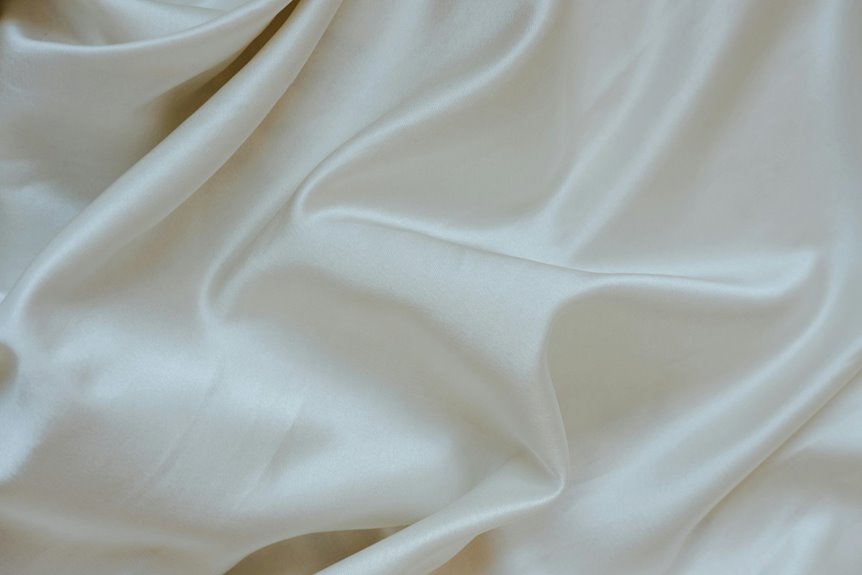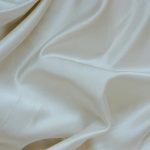Percale is a crisp, breathable fabric woven in a tight one-over-one-under pattern, usually from 100% cotton, offering a lightweight and durable feel. You’ll appreciate its cool, matte finish that stays fresh through frequent washes and helps you sleep comfortably in warmer climates. Unlike heavier fabrics, percale resists pilling and offers lasting quality with a natural texture. If you want to understand how it compares with other materials and find the perfect set for you, keep exploring these insights.
Table of Contents
Key Takeaways
- Percale is a tightly woven plain weave fabric known for its crisp, matte finish and lightweight, breathable feel.
- Made typically from 100% cotton, it offers durability, breathability, and a cool, smooth texture ideal for bedding.
- Percale bedding is long-lasting, maintains color vibrancy, resists pilling, and stays crisp after frequent washing.
- Its breathable weave makes it perfect for warm climates and seasons, providing comfort on hot nights.
- Percale sheets require gentle care, including cold or warm washing and low-heat drying, to preserve softness and durability.
Understanding the Percale Weave
The percale weave creates a crisp, matte finish by weaving threads in a simple one-over, one-under pattern. When you look closely, you’ll see that each thread crosses over one thread and under the next, creating a tight and even surface.
This straightforward structure makes the fabric sturdy without adding bulk. You’ll find that percale’s weave allows air to flow freely, which keeps the fabric breathable and fresh.
The weave also helps the fabric resist pilling and maintain its smooth texture through many washes. By understanding how the percale weave works, you can appreciate why it feels cool and crisp against your skin, making it a smart choice for bedding, especially if you prefer a lightweight and durable fabric.
Key Characteristics of Percale Fabric
When you choose percale, you’ll notice its crisp weave pattern that creates a smooth, matte finish.
The fabric’s material makeup, often 100% cotton, plays a big role in its breathability and durability.
You’ll also appreciate the cool, lightweight feel that makes percale perfect for a comfortable night’s sleep.
Weave Pattern Details
Although you mightn’t always notice it, the weave pattern plays an essential role in defining percale’s crisp feel and durability.
Percale features a plain weave, where threads cross over and under one another in a simple, tight, and consistent pattern. This structure creates a smooth surface with a matte finish, different from the glossy sateen weave.
Because of this tight interlacing, percale resists pilling and holds up well to frequent washing. You’ll also find that this weave allows air to circulate, making the fabric breathable and comfortable for warm nights.
When you pick percale, you’re choosing a fabric whose weave pattern guarantees it stays crisp, strong, and cool, giving you lasting comfort every time you sleep.
Material Composition Insights
Percale’s distinctive crispness and breathability come not just from its weave but also from the materials used in its construction.
When you choose percale fabric, you’re typically selecting from a range of natural and synthetic fibers, each influencing durability, softness, and breathability.
Understanding these materials helps you pick the best percale for your needs.
- 100% cotton: Offers natural breathability and durability
- Cotton-polyester blend: Adds wrinkle resistance and strength
- Organic cotton: Grown without chemicals, ideal for sensitive skin
- Egyptian cotton: Known for extra-long fibers, enhancing softness and longevity
- Supima cotton: A premium American cotton valued for its smoothness and durability
Knowing these options lets you select percale fabric that fits your lifestyle perfectly.
Texture and Feel
You’ll notice that percale fabric feels crisp and cool to the touch, setting it apart from other weaves. Its tight, plain weave creates a smooth surface, making it ideal for warm climates or those who tend to sleep hot. Unlike sateen, percale isn’t shiny but offers a matte finish that feels invigorating and breathable.
Here’s a quick look at what you can expect from percale’s texture and feel:
| Feature | Description | Benefit |
|---|---|---|
| Crispness | Firm and smooth surface | Feels invigorating |
| Breathability | Tight but airy weave | Keeps you cool |
| Matte Finish | No sheen or gloss | Subtle, elegant look |
| Durability | Strong fibers, high thread count | Long-lasting softness |
How Percale Differs From Other Weaves
When you compare percale to other weaves, its crisp, matte finish and tight, one-over-one-under pattern stand out clearly.
This simple yet effective weave gives percale a distinctive texture that’s smoother and more breathable than many alternatives.
Unlike sateen, which has a glossy surface and a heavier feel, percale feels light and fresh against your skin.
It’s also different from twill weaves, which create diagonal lines and a denser fabric.
Here’s how percale differs:
- Uses a balanced plain weave for durability and crispness
- Produces a matte, non-shiny finish
- Feels cooler and more breathable than sateen
- Has a lighter, less dense texture compared to twill
- Maintains a smooth surface without the softness of knits
You’ll notice these differences as soon as you touch it.
The Benefits of Choosing Percale Bedding
When you choose percale bedding, you get sheets that stand up to frequent washing without losing their crisp feel.
You’ll also enjoy excellent breathability, which keeps you cool and comfortable all night.
These benefits make percale a smart choice for long-lasting, revitalizing sleep.
Durability and Longevity
Although many bedding options promise comfort, percale stands out for its exceptional durability and longevity. When you choose percale sheets, you’re investing in bedding that lasts through countless washes without losing its crisp texture or vibrant color.
Its tight weave strengthens the fabric, making it resistant to pilling and wear. You’ll appreciate how percale maintains its shape and smoothness over time, giving you consistent quality night after night.
Here’s why percale excels in durability:
- High thread count enhances fabric strength
- Tightly woven fibers resist tears and snags
- Maintains crispness after repeated washing
- Less prone to pilling compared to other weaves
- Colors stay vibrant longer due to stable dye retention
Opting for percale means your sheets stay fresh and reliable for years.
Breathability and Comfort
Because percale features a crisp, lightweight weave, it keeps you cool and comfortable throughout the night. The breathable fabric promotes airflow, preventing heat buildup and moisture, so you wake up feeling fresh. If you tend to sleep hot, percale is an excellent choice to regulate your temperature naturally.
Here’s a quick comparison to help you understand percale’s advantages:
| Feature | Percale Bedding |
|---|---|
| Breathability | High – promotes airflow |
| Moisture Control | Excellent – wicks away sweat |
| Comfort Level | Crisp, cool, and smooth |
Choosing percale means investing in bedding that works with your body, ensuring a more restful, comfortable sleep every night.
Ideal Climate and Seasons for Percale Sheets
If you prefer crisp, breathable bedding, percale sheets suit warmer climates and seasons best. Their lightweight weave lets air flow freely, keeping you cool and comfortable when temperatures rise.
You’ll find percale especially invigorating during:
- Hot summer nights when humidity is high
- Spring and early fall when the weather is mild but not chilly
- Tropical or subtropical regions with consistently warm temperatures
- Dry climates where moisture-wicking enhances comfort
- Shifting seasons when you want a cool, crisp feel without extra warmth
While percale offers a cool touch, it’s less insulating than flannel or sateen, so you might want to switch to warmer sheets in winter.
But if you live somewhere warm or want breathable sheets year-round, percale’s crisp texture is a smart choice.
Percale Thread Count: What You Need to Know
When you shop for percale sheets, understanding thread count can help you make a better choice.
Thread count refers to the number of threads woven per square inch of fabric. For percale, a thread count between 200 and 400 is ideal. This range guarantees a crisp, breathable texture without sacrificing durability.
Higher thread counts don’t always mean better quality; percale’s strength comes from its tight plain weave, not just thread density. If the count is too low, the fabric might feel rough or less durable. If it’s too high, the sheets can lose their signature crispness and become heavier.
Caring for Your Percale Bedding
Choosing the right thread count sets you up for the best percale experience, but how you care for your sheets will keep them feeling crisp and fresh.
To maintain that cool, breathable texture, follow these essential care tips. Wash your percale bedding in cold or warm water to protect the fibers and prevent shrinkage. Avoid bleach, which can weaken the fabric. Use a gentle cycle and mild detergent to preserve softness. Tumble dry on low heat or air dry to prevent damage.
Remove sheets promptly to minimize wrinkles and make ironing easier if you prefer a perfectly smooth finish.
- Wash separately to avoid abrasion
- Avoid fabric softeners; they reduce crispness
- Turn sheets inside out before washing
- Store in a cool, dry place
- Iron on low heat if desired
Common Misconceptions About Percale
Although percale is celebrated for its crisp feel and durability, many people misunderstand what makes it unique. You might think percale is always rough or stiff, but that’s not true. It actually softens with each wash while maintaining its crisp texture.
Some believe percale wrinkles easily, which can be true, but this isn’t a flaw—it’s part of its natural charm and breathability. Others assume percale is only made from cotton, but it can also include blends like polyester.
Finally, you might hear that percale is only for warm climates, yet its breathability makes it comfortable year-round. Knowing these facts helps you appreciate percale’s versatility and why it’s a popular choice for quality bedding.
How to Choose the Right Percale Sheets for You
Since percale sheets come in various qualities and blends, you’ll want to contemplate factors like thread count, material, and weave to find the best fit for your needs.
Consider thread count, material, and weave to choose the perfect percale sheets for your comfort.
Start by choosing a thread count between 200 and 400 for durability without sacrificing breathability. Opt for 100% cotton for a crisp, natural feel, or consider cotton blends if you want added softness or wrinkle resistance.
Look for a tight, even weave to guarantee longevity and a smooth texture. Don’t forget to check for certifications like OEKO-TEX for safe, chemical-free fabrics.
Finally, consider your climate and sleeping preferences—lighter percale suits warm nights, while denser weaves provide more warmth.
- Thread count: 200-400 for balance
- Material: 100% cotton or blends
- Weave quality: tight and even
- Certifications: OEKO-TEX or similar
- Climate and personal comfort preferences
Frequently Asked Questions
Is Percale Fabric Environmentally Friendly?
Think of percale fabric as a refreshing change for your sheets. You’ll find it’s often made from cotton, a renewable resource, but its environmental impact depends on farming practices, so choose organic for greener sleep.
Can Percale Be Used for Clothing?
Yes, you can use percale for clothing. It’s lightweight, breathable, and has a crisp feel, making it great for shirts or dresses. You’ll appreciate its durability and smooth texture for everyday wear.
Are Percale Sheets Hypoallergenic?
Yes, percale sheets are hypoallergenic because their tight weave helps resist dust mites and allergens. If you have sensitive skin or allergies, you’ll appreciate how percale keeps your sleeping environment clean and comfortable.
How Long Do Percale Sheets Typically Last?
You want durability, comfort, and breathability in sheets. Percale sheets typically last 3 to 5 years if you care for them properly. You’ll enjoy crisp, cool nights while they maintain their quality and feel.
Does Percale Fabric Shrink After Washing?
Yes, percale fabric can shrink slightly after washing, especially if it’s 100% cotton. You’ll want to wash in cold water and avoid high heat drying to minimize shrinkage and keep your sheets fitting perfectly.
- Does Chiffon Fabric Stink - July 15, 2025
- Does Chiffon Fabric Affect the Economy - July 15, 2025
- Does Cotton Fabric Have a Nap - July 15, 2025







